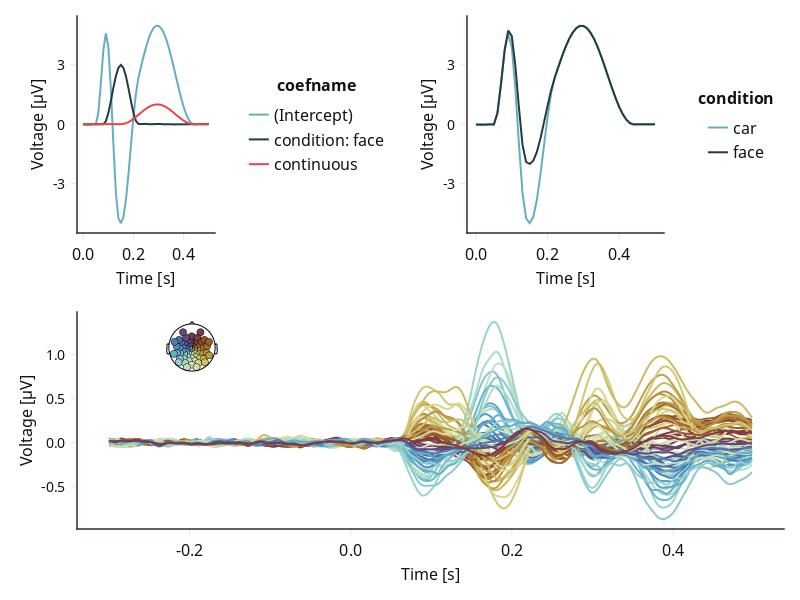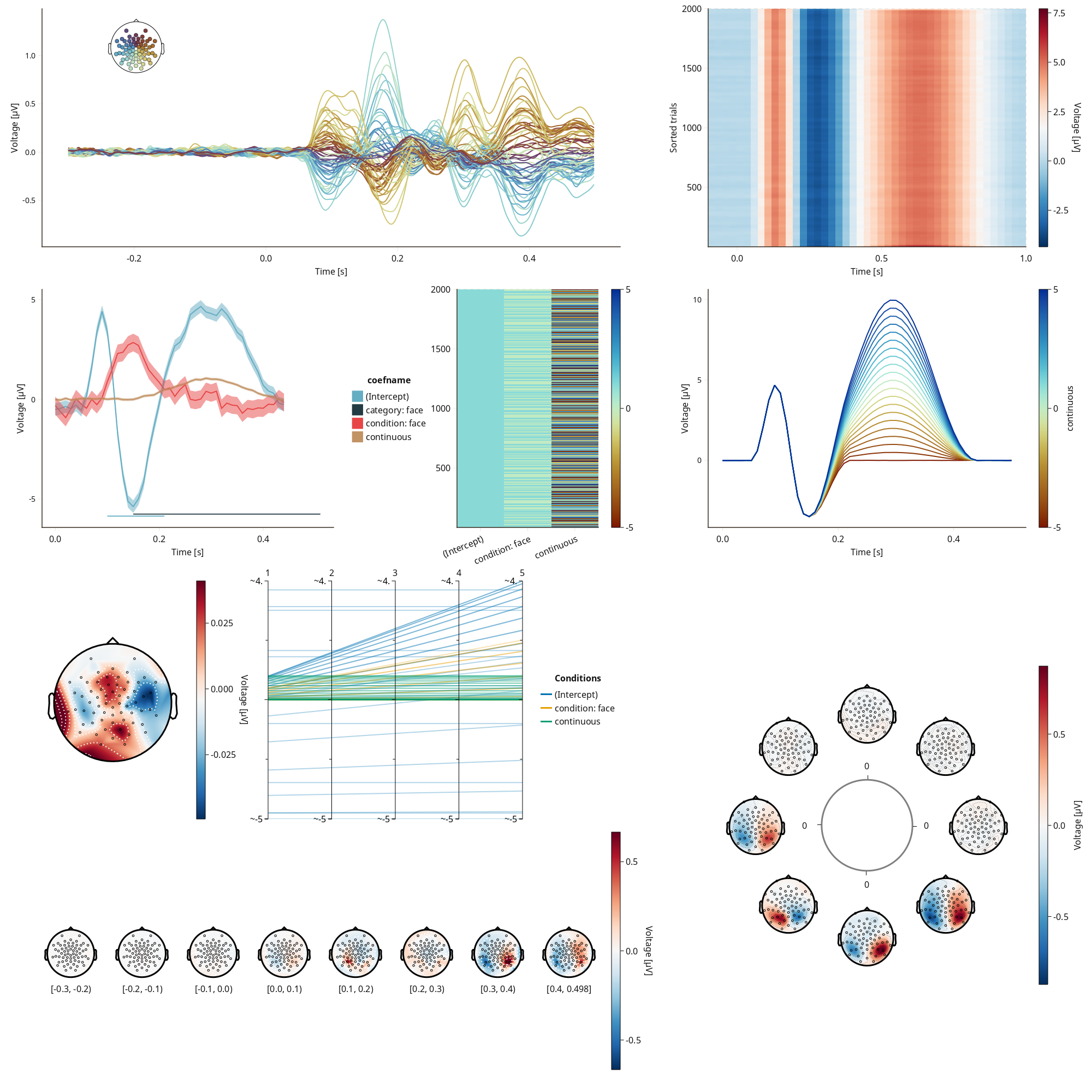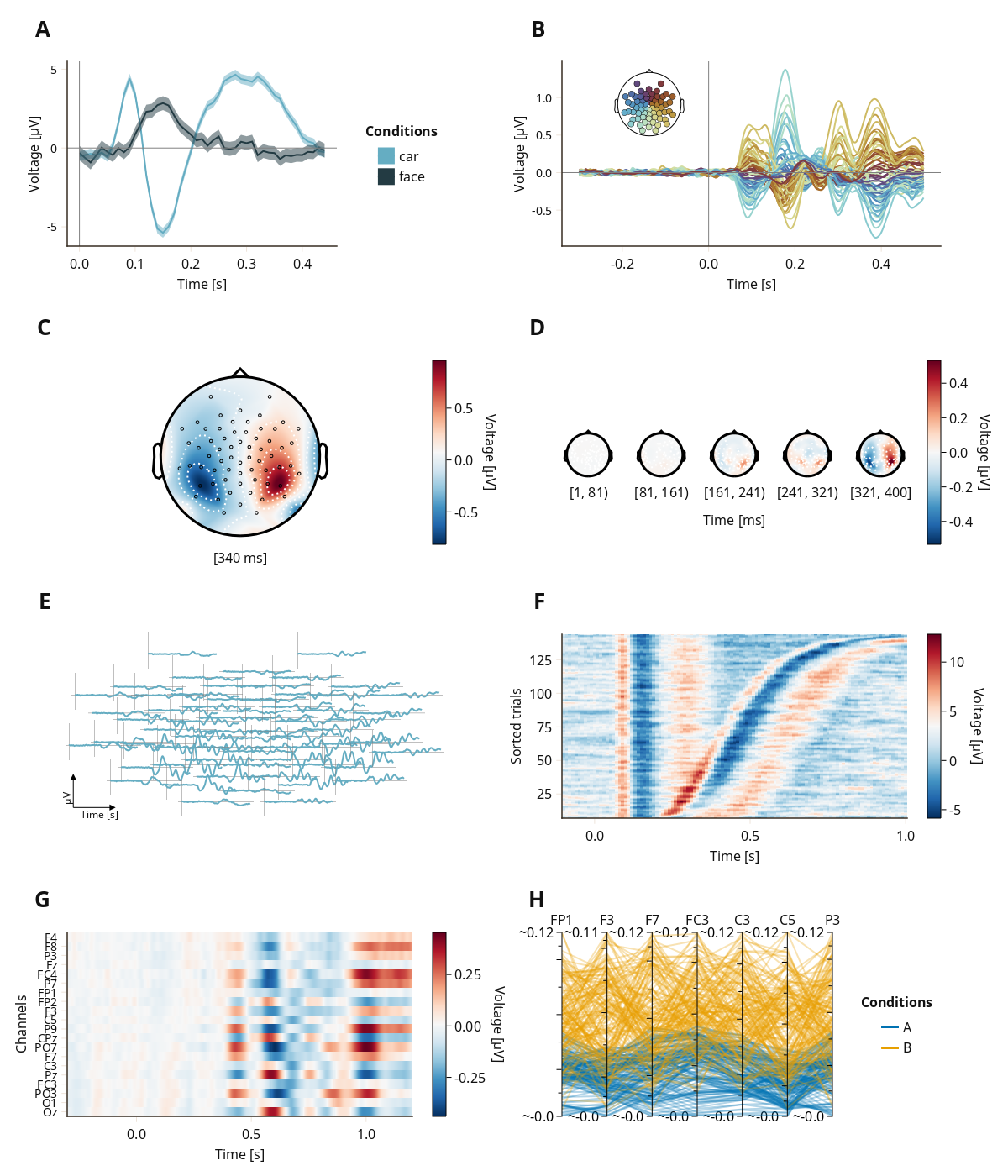Include multiple Visualizations in one Figure
This section discusses how users can incorporate multiple plots into a single figure.
Library load
using UnfoldMakie
using CairoMakie
using DataFramesMeta
using UnfoldSim
using Unfold
using MakieThemes
set_theme!(theme_ggthemr(:fresh)) # nicer defaults - should maybe be default?Data input
include("../../../example_data.jl")
d_topo, positions = example_data("TopoPlots.jl")
uf_deconv = example_data("UnfoldLinearModelContinuousTime")
uf = example_data("UnfoldLinearModel")
results = coeftable(uf)
uf_5chan = example_data("UnfoldLinearModelMultiChannel")
data, positions = TopoPlots.example_data()
dat_e, evts, times = example_data("sort_data")
d_singletrial, _ = UnfoldSim.predef_eeg(; return_epoched = true)
#=
By using the !-version of the plotting function and inserting a grid position instead of an entire figure, we can create complex plot combining several figures.
We will start by creating a figure with `Makie.Figure`.
`f = Figure()`
Now any plot can be added to `f` by placing a grid position, such as `f[1, 1]`.
=#
f = Figure()
plot_erp!(f[1, 1], coeftable(uf_deconv))
plot_erp!(
f[1, 2],
effects(Dict(:condition => ["car", "face"]), uf_deconv),
mapping = (; color = :condition),
)
plot_butterfly!(f[2, 1:2], d_topo; positions = positions)
f
Very complex plot
Using the data from the tutorials, we can create a large image with any type of plot.
With so many plots at once, it's tempting to set a fixed resolution in your image to order the plots evenly (code below).
f = Figure(resolution = (2000, 2000))
plot_butterfly!(f[1, 1:3], d_topo; positions = positions)
pvals = DataFrame(
from = [0.1, 0.15],
to = [0.2, 0.5], # if coefname not specified, line should be black
coefname = ["(Intercept)", "category: face"],
)
plot_erp!(
f[2, 1:2],
results,
categorical_color = false,
categorical_group = false,
pvalue = pvals,
stderror = true,
)
plot_designmatrix!(f[2, 3], designmatrix(uf))
plot_topoplot!(f[3, 1], data[:, 150, 1]; positions = positions)
plot_topoplotseries!(
f[4, 1:3],
d_topo,
0.1;
positions = positions,
mapping = (; label = :channel),
)
res_effects = effects(Dict(:continuous => -5:0.5:5), uf_deconv)
plot_erp!(
f[2, 4:5],
res_effects;
categorical_color = false,
categorical_group = true,
mapping = (; y = :yhat, color = :continuous, group = :continuous),
legend = (; nbanks = 2),
layout = (; show_legend = true, legend_position = :right),
)
plot_parallelcoordinates(
f[3, 2:3],
uf_5chan;
mapping = (; color = :coefname),
layout = (; legend_position = :right),
)
plot_erpimage!(f[1, 4:5], times, d_singletrial)
plot_circulareegtopoplot!(
f[3:4, 4:5],
d_topo[in.(d_topo.time, Ref(-0.3:0.1:0.5)), :];
positions = positions,
predictor = :time,
predictor_bounds = [-0.3, 0.5],
)
f
In two columns
f = Figure(resolution = (1200, 1400))
ga = f[1, 1]
gc = f[2, 1]
ge = f[3, 1]
gg = f[4, 1]
gb = f[1, 2]
gd = f[2, 2]
gf = f[3, 2]
gh = f[4, 2]
d_topo, pos = example_data("TopoPlots.jl")
data, positions = TopoPlots.example_data()
df = UnfoldMakie.eeg_matrix_to_dataframe(data[:, :, 1], string.(1:length(positions)))
raw_ch_names = [
"FP1", "F3", "F7", "FC3", "C3", "C5", "P3", "P7", "P9", "PO7", "PO3", "O1",
"Oz", "Pz", "CPz", "FP2", "Fz", "F4", "F8", "FC4", "FCz", "Cz",
"C4", "C6", "P4", "P8", "P10", "PO8", "PO4", "O2",
]
m = example_data("UnfoldLinearModel")
results = coeftable(m)
results.coefname =
replace(results.coefname, "condition: face" => "face", "(Intercept)" => "car")
results = filter(row -> row.coefname != "continuous", results)
plot_erp!(ga, results; :stderror => true, mapping = (; color = :coefname => "Conditions"))
hlines!(0, color = :gray, linewidth = 1)
vlines!(0, color = :gray, linewidth = 1)
plot_butterfly!(
gb,
d_topo;
positions = pos,
topomarkersize = 10,
topoheigth = 0.4,
topowidth = 0.4,
)
hlines!(0, color = :gray, linewidth = 1)
vlines!(0, color = :gray, linewidth = 1)
plot_topoplot!(gc, data[:, 340, 1]; positions = positions, axis = (; xlabel = "[340 ms]"))
plot_topoplotseries!(
gd,
df,
80;
positions = positions,
visual = (label_scatter = false,),
layout = (; use_colorbar = true),
)
ax = gd[1, 1] = Axis(f)
text!(ax, 0, 0, text = "Time [ms]", align = (:center, :center), offset = (-20, -80))
hidespines!(ax) # delete unnecessary spines (lines)
hidedecorations!(ax, label = false)
plot_erpgrid!(
ge,
data[:, :, 1],
positions;
axis = (; ylabel = "µV", ylim = [-0.05, 0.6], xlim = [-0.04, 1]),
)
dat_e, evts, times = example_data("sort_data")
plot_erpimage!(gf, times, dat_e; sortvalues = evts.Δlatency)
plot_channelimage!(gg, data[:, :, 1], positions[1:30], raw_ch_names;)
r1, positions = example_data()
r2 = deepcopy(r1)
r2.coefname .= "B" # create a second category
r2.estimate .+= rand(length(r2.estimate)) * 0.1
results_plot = vcat(r1, r2)
plot_parallelcoordinates(
gh,
subset(results_plot, :channel => x -> x .< 8, :time => x -> x .< 0);
mapping = (; color = :coefname),
normalize = :minmax,
ax_labels = ["FP1", "F3", "F7", "FC3", "C3", "C5", "P3", "P7"],
)
for (label, layout) in
zip(["A", "B", "C", "D", "E", "F", "G", "H"], [ga, gb, gc, gd, ge, gf, gg, gh])
Label(
layout[1, 1, TopLeft()],
label,
fontsize = 26,
font = :bold,
padding = (20, 20, 22, 0),
halign = :right,
)
end
f
This page was generated using Literate.jl.